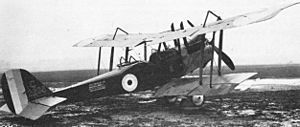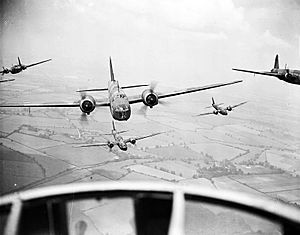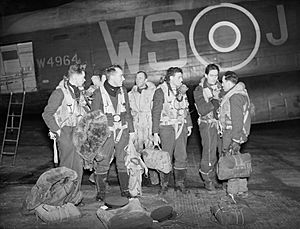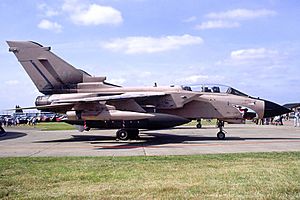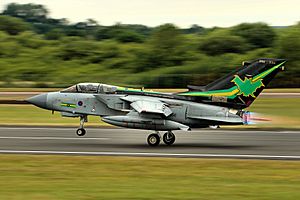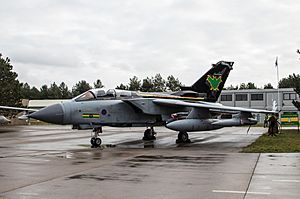No. 9 Squadron RAF facts for kids
Quick facts for kids No. IX (B) Squadron RAF |
|
|---|---|

Squadron badge
|
|
| Active | 8 December 1914 – 22 March 1915 (RFC) 1 April 1915 – 1 April 1918 (RFC) 1 April 1918 – 31 December 1919 (RAF) 1 April 1924 – 13 July 1961 1 March 1962 – 29 April 1982 1 June 1982 – 14 March 2019 1 April 2019 – present |
| Country | |
| Branch | |
| Role | Air defence, Aggressor |
| Part of | No. 1 Group (Air Combat) |
| Home station | RAF Lossiemouth |
| Motto(s) | Per noctem volamus (Latin for 'We fly through the night') |
| Equipment | Eurofighter Typhoon FGR.4 |
| Battle honours |
|
| Commanders | |
| Current commander |
Wing Commander Richard Leask |
| Insignia | |
| Squadron badge | A green bat with wings extended. |
| Squadron badge heraldry | Approved by King Edward VIII in November 1936 as an authorised version of a badge highlighting the squadron's night-bombing role. |
| Squadron roundel |  |
| Squadron codes | KA (Feb 1939 – Sep 1939) WS (Sep 1939 – Apr 1951) AA–AZ (Aug 1986 – Mar 2019) WS (May 2019 – present) |
No. 9 Squadron, also called No. IX (Bomber) Squadron, is the oldest bomber squadron in the Royal Air Force (RAF). It started in December 1914 and fought in World War I, including famous battles like the Somme and Passchendaele.
In World War II, No. 9 Squadron was one of two special units that used Avro Lancaster planes for very accurate bombing. They famously sank the huge German battleship Tirpitz on November 12, 1944. From 1962 to 1982, they flew the Avro Vulcan B.2 bomber as part of the 'V-Force'. In 1982, they became the first squadron anywhere to use the Panavia Tornado GR.1 jet. In 1998, No. 9 Squadron got the RAF's first Tornado GR.4. They used it until April 1, 2019, when they switched to the Eurofighter Typhoon FGR.4 at their current base, RAF Lossiemouth.
Contents
History
World War I Missions
No. 9 Squadron began on December 8, 1914, in France. It was the first RAF squadron formed outside the UK. Its job was to use radio to help with reconnaissance and artillery spotting. This early squadron was disbanded in March 1915.
The squadron reformed on April 1, 1915, in England. Major Hugh Dowding led it. He later became a key leader in the Battle of Britain. The squadron trained with planes like the Farman MF.7 and Royal Aircraft Factory B.E.2. They were nicknamed The Bats.
In December 1915, they returned to France. They started bombing missions in January 1916. They flew reconnaissance and spotted artillery during the Battle of the Somme in 1916. They also helped in the Second Battle of Arras in 1917.
In May 1917, they started using Royal Aircraft Factory R.E.8 planes. They used them for spotting and patrols during the Battle of Passchendaele. They also did short bombing missions in response to the German spring attack in 1918. The squadron returned to the UK in August 1919 and was disbanded in December 1919.
Between the Wars
No. 9 Squadron became a bomber unit on April 1, 1924. They started with the Vickers Vimy plane. Less than a year later, they got the Vickers Virginia heavy bomber. In 1936, they switched to the Handley Page Heyford.
King Edward VIII approved the squadron's badge in 1936. The badge shows a bat and the motto "We Fly by Night." This reflects their role in night operations. It's a playful nod to Air Marshal Hugh "Boom" Trenchard. He once said, "Only bats and bloody fools fly at night!"
In January 1939, No. 9 Squadron was one of the first to get the modern Vickers Wellington bomber.
World War II Operations
Early War (1939–1943)
When World War II started, No. 9 Squadron had modern Vickers Wellington bombers. They were based at RAF Honington. On September 4, 1939, their planes were the first to attack the enemy. They were also the first to get into a dogfight and possibly shoot down an enemy plane.
Later, in September 1942, the squadron moved to RAF Waddington. They switched to the Avro Lancaster bomber. This plane helped them complete their most famous missions.

No. 9 Squadron fought throughout World War II with RAF Bomber Command. They took part in all major raids and battles. They helped develop new tactics and equipment. Some of their members were involved in the famous Great Escape.
They became one of two special squadrons that attacked targets with the huge Tallboy bomb. They led the final main raid of the war on April 25, 1945. This raid was on Berchtesgaden, Germany.
Sinking the Tirpitz (1944)
The German battleship Tirpitz was hidden in a fjord in Northern Norway. It was a threat to Arctic convoys (groups of ships). It was too far north for UK-based planes to attack. It had been damaged before, but not sunk.
No. 9 and No. 617 Squadrons were given the task. They flew from a base in Russia and attacked Tirpitz with Tallboy bombs. The damage was so bad that the ship was moved to Tromsø to be used as a floating gun battery. This new location was within range of bombers from Scotland.
On November 12, 1944, the two squadrons attacked Tirpitz again. The first bombs missed, but later planes scored three direct hits. This caused the ship to capsize (turn over). All three RAF attacks on Tirpitz were led by Wing Commander J. B. "Willy" Tait.
The sinking of the warship is mainly credited to a Tallboy bomb dropped by a No. 9 Squadron Lancaster. The pilot, Flying Officer Dougie Tweddle, received the Distinguished Flying Cross (DFC) for his bravery.
End of War (1945)
On April 25, 1945, No. 9 Squadron flew its last mission of the war. They attacked Obersalzberg with No. 617 Squadron. Their targets included Adolf Hitler's homes, the Berghof and Eagle's Nest.
After the war in Europe ended, No. 9 Squadron was part of the 'Tiger Force'. This force was meant to attack Japan. However, the war ended in August 1945 after the Atomic bombings of Hiroshima and Nagasaki. No. 9 Squadron then went to India for aerial survey work until April 1946.
After the War
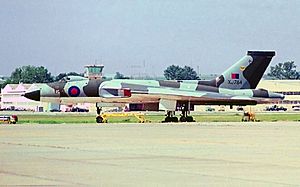
After the war, the Lancasters were replaced by Avro Lincoln planes. In 1952, the squadron got English Electric Canberra B.2 jet-bombers. These planes were used in Malaya in 1956 and during the Suez Crisis. No. 9 Squadron was disbanded on July 13, 1961.
It reformed on March 1, 1962, and started using the Avro Vulcan B.2. This plane was part of the RAF's V-Force. Their Vulcans carried WE.177 nuclear bombs. They were based in Cyprus for six years, then at RAF Waddington. The squadron disbanded again in April 1982.
Tornado GR Era (1982–2019)
New Beginnings (1982–1990)
No. 9 Squadron started forming again in early 1982. They received their first Panavia Tornado GR.1 jet on January 6. The squadron officially reformed on June 1, becoming the world's first operational Tornado squadron. They were also equipped with WE.177 nuclear bombs.
On September 27, 1983, No. 9 Squadron had the RAF's first Tornado loss. The plane had an electrical failure. The navigator ejected safely, but the pilot was lost.
The squadron was featured in a 1985 RAF recruitment film called Tornado. In October 1986, No. 9 Squadron moved to RAF Brüggen in Germany.
Gulf War and Beyond (1991–1998)
In 1990, before the First Gulf War, No. 9 Squadron personnel went to Saudi Arabia and Bahrain. As part of Operation Granby, their crews flew missions starting January 17, 1991. They aimed to gain control of the air over Iraq. They bombed Iraqi air bases and runways.
The squadron lost one Tornado during this time due to a control issue, but no combat losses. No. 9 Squadron flew 200 missions and dropped 300 bombs.
After the war, no-fly zones were set up over Iraq. No. 9 Squadron helped patrol these zones. In May 1998, they received the RAF's first Tornado GR.4. In 2001, the squadron moved to RAF Marham.

Kosovo and Iraq (1999–2009)
No. 9 Squadron took part in the 1999 NATO bombing of Yugoslavia to free Kosovo. They flew missions from Germany and later from Corsica. In 1999, No. 9 Squadron became the first operational Tornado GR.4 squadron.
In February 2003, the squadron was part of the Second Gulf War (Operation Telic). They were based in Kuwait. On March 22, 2003, one of their aircraft was shot down by a friendly Patriot missile battery. Both the pilot and navigator were killed.
From 2004 to 2010, No. 9 Squadron deployed annually to support Operation Telic.
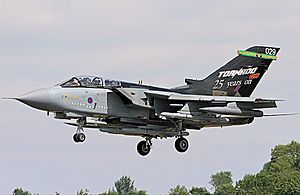
Afghanistan and Libya (2010–2011)
No. 9 Squadron had its first tour in Operation Herrick in Afghanistan in January 2010. Their Tornado GR.4s flew close air support missions for ground troops. They also did many reconnaissance missions. They completed 450 flights and almost 40 support missions.
In March 2011, No. 9 Squadron was the first RAF Tornado squadron to join Operation Ellamy in Libya. They performed long-range attacks from their home base in the UK. They later moved to Italy to continue operations. The conflict ended on October 20, 2011. The squadron returned home on November 1, 2011. No. 9 Squadron was one of only three RAF squadrons to earn the battle honour Libya 2011.
Later Tornado Years (2012–2019)
No. 9 Squadron returned to Afghanistan in December 2012 for Operation Herrick. They were deployed for four months. In 2014, they took part in Exercise Red Flag in the USA.
Their last deployment to Afghanistan was in June 2014. To celebrate 100 years of No. 9 Squadron, a Tornado GR.4 was painted in a special design.
In August 2014, RAF Tornado GR.4s were sent to help refugees in Iraq. This was due to attacks by Daesh. In September, Parliament approved airstrikes against Daesh. No. 9 Squadron helped with these missions. In December 2015, they also attacked Daesh oil fields in Syria.
On April 14, 2018, No. 9 Squadron participated in missile strikes against Syria. This was in response to a suspected chemical attack. In July 2018, nine Tornados from No. 9 and No. 31 Squadrons flew over London. This celebrated the RAF's 100th anniversary.
On March 14, 2019, No. 9 and No. 31 Squadrons held a joint parade. This marked the end of the Tornado GR Force. No. 9 Squadron was the world's first and the RAF's joint-last operational Tornado squadron.
Eurofighter Typhoon Era (2019 onwards)
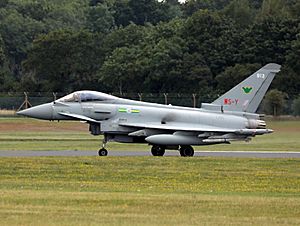
In February 2019, four Eurofighter Typhoon FGR4s were assigned to No. 9 Squadron. On April 1, 2019, No. 9 Squadron officially switched to the Typhoon. They became an aggressor and air defence squadron. This meant they continued their service without interruption after the Tornado retired.
On March 24, 2020, No. 9 Squadron received the battle honour 'Afghanistan 2001–2014'. This was for their part in Operation Herrick. On May 8, 2020, two of their Typhoons flew over Edinburgh to mark the 75th anniversary of VE Day.
In November 2020, the Bats sent Typhoons to Turkey for training. In April 2021, four Typhoons deployed to Romania. They helped with NATO's air policing efforts. In March 2023, No. 9 Squadron deployed to Estonia. They worked with the German Air Force.
Aircraft Operated
Aircraft operated include:
- Royal Aircraft Factory B.E.2a (Dec 1914–Feb 1915)
- Farman MF.7 (Dec 1914–Feb 1915; Apr 1915–Nov 1915)
- Blériot XI (Dec 1914–Mar 1915; Apr 1915–Aug 1915)
- Farman MF.11 (Dec 1914–Mar 1915)
- Blériot XI Parasol (Jan 1915–Mar 1915)
- Royal Aircraft Factory B.E.2b (Jan 1915–Feb 1915)
- Royal Aircraft Factory B.E.2c (Jan 1915–Feb 1915; Aug 1915–Oct 1916)
- Royal Aircraft Factory B.E.2 (Apr 1915–Jul 1915)
- Royal Aircraft Factory B.E.8a (Jul 1915–Nov 1915)
- Avro 504 (Jul 1915–Nov 1915)
- Martinsyde S.1 (Jul 1915–Nov 1915)
- Royal Aircraft Factory R.E.7 (Nov 1915–Nov 1915)
- Bristol Scout (Dec 1915–Jun 1916)
- Royal Aircraft Factory B.E.2d (Jun 1916–Sep 1916)
- Royal Aircraft Factory B.E.2e (Aug 1916–Jun 1917)
- Royal Aircraft Factory R.E.8 (May 1917–May 1919)
- Bristol F.2b (Jul 1918–Oct 1918; Feb 1919–Jul 1919)
- Vickers Vimy (Apr 1924–Oct 1925)
- Vickers Virginia Mk.IV (Sep 1924–Mar 1927)
- Vickers Virginia Mk.V (Jan 1925–May 1926)
- Vickers Virginia Mk.VI (Jun 1925–Apr 1927)
- Vickers Virginia Mk.VII (Jul 1926–Jun 1930)
- Vickers Virginia Mk.VIII (Jan 1927–Mar 1927)
- Vickers Virginia Mk.IX (Jul 1927–Feb 1932)
- Vickers Virginia Mk.X (Jan 1929–Apr 1936)
- Handley Page Heyford Mk.III (Mar 1936–May 1939)
- Vickers Wellington Mk.I (Jan 1939–Dec 1939)
- Vickers Wellington Mk.Ia (Sep 1939–Sep 1940)
- Vickers Wellington Mk.Ic (Feb 1940–Oct 1941; May 1942–Jun 1942)
- Vickers Wellington Mk.II (Mar 1941–Aug 1941)
- Vickers Wellington Mk.III (Jul 1941–Aug 1942)
- Avro Lancaster Mk.I (Sep 1942–Dec 1945; May 1946–Jul 1946)
- Avro Lancaster Mk.III (Sep 1942–Dec 1945; May 1946–Jul 1946)
- Avro Lancaster Mk.VII (Nov 1945–Apr 1946)
- Avro Lincoln B.2 (Jul 1946–May 1952)
- English Electric Canberra B.2 (May 1952–Jun 1956)
- English Electric Canberra B.6 (Sep 1955–Jul 1961)
- Avro Vulcan B.2 (Apr 1962–Apr 1982)
- Panavia Tornado GR.1 (Jan 1982–1999)
- Panavia Tornado GR.4 (May 1998–Mar 2019)
- Eurofighter Typhoon FGR.4 (Feb 2019–present)
Affiliations
No. IX (B) Squadron is connected to HMS St Albans (a Royal Navy ship), the King's Royal Hussars (an army regiment), and the Worshipful Company of Haberdashers (a historic London guild). In March 2017, the squadron became partners with No. 9 Squadron of the Pakistan Air Force.
Memorial
In the village of Bardney, Lincolnshire, there is a memorial for all the service members killed or missing between 1939 and 1945. More than 452 No. 9 Squadron aircrew died during the 27 months that RAF Bardney was active. The No. IX (B) Squadron RAF War Memorial was unveiled on October 19, 1980.
See also
- List of RAF squadrons


